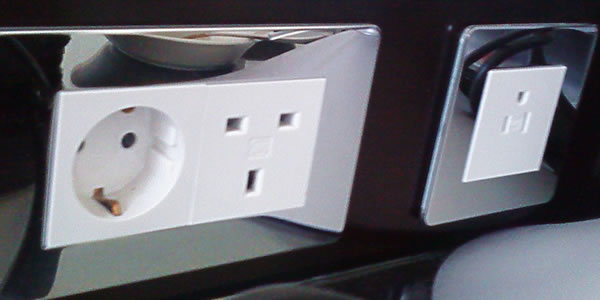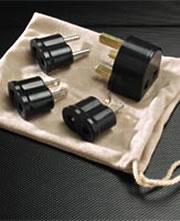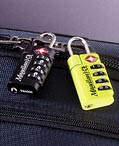- Places
- Plans
- Itineraries
- Experiences

Few hotels are kind enough to provide outlets for different kinds of plugs (left: the two round pins of Continental Europe; middle: the three fat prongs of the U.K; right: the mismatched flat tines of North America.) (Photo by Andrew Skudder)

Plug adapters make the two thin, flat prongs of a U.S. electronic device fit the two round pin-holes (or three fat, flat plugs of England) in Europe.
Used to be the only piece of electronic equipment I traveled with that wasn't battery-powered was my trusty Mac laptop—and I only need that because I have this strange job of writing about my travels.
Nowadays, of course, I also have to lug a digital camera and my smartphone. All these things need to be charged with a tangle of cables—plus the needlessly chunky plastic charging fobs for camera batteries.
Yes, electronics of any kind are just a big hassle on the road. They take up excess room in your luggage, take time out of your schedule, and often put hotel fuses out of commission. This hassle is five times worse with anything that has a cord.
As it says on the Ultimate Packing List, take a small battery-operated alarm clock, and one of those teensy flashlights for poking around ancient ruins and finding stuff in the dark.
Beyond that, travel with as few electronics as you think you can get away with.
Still determined to lug around half a Radio Shack? Well, here's what you need to know.
First of all, most modern devices designed to travel are dual-voltage—hairdryers, laptops, digital cameras, camcorders, smartphones—which means they have a built-in converter to deal with differences in volts and amps. (Do not, however, assume this; more on converters in a minute).
That means all you will likely need is a handful of plug adaptors.

Plug adapters make the two flat prongs of a U.S. electronic device fit the two round pin-holes (or three slanted flat plugs of England) in Europe.
You cannot plug an American (or U.K.) appliance into an Italian wall because the plug simply won't fit.
American plug prongs are flat and parallel. In Italy, appliance plugs use two round holes. (Same goes for more of the rest of Europe, except in the U.K. and Ireland, which have large, funky plugs made from three huge, flattened fingers of metal arranged in a triangle and set at perpendicular angles).
You can get small plug adaptors that make the switch, but these are not currency converters.
Unless your electronic device is dual voltage, you still need to go through a transformer to get the electrical current running properly.
American current runs 110V, 60 cycles. Italy (and the rest of Europe) runs 210 to 220V and 50 cycles.
You can't plug a standard American appliance into an Italian outlet without frying your appliance and/or blowing a fuse. You need a currency converter or transformer to bring the voltage down and the cycles up.
This is far less of a concern than it used to be, since most modern devices designed to travel—hairdryers, laptops, digital cameras, camcorders, cell phones—are what are known as dual-voltage, which means they have a converter built in. Don't assume that this is always the case, however:
Most portabel electronics have long since fixed this problem, but do be a bit wary. As "recently" as 2003, I plugged a Palm charger into the outlet in an Irish B&B without bothering to check if it was dual-voltage because: hey; it was the original smartphone, right, a portable device designed to take globetrotting with you?
It instantly blew the fuse in the B&B (causing me untold embarrassment), and it also fused the circuits of the charging unit itself. This sucked, since I was planning to use the PDA to take notes for the article I was writing, but there was no way to charge it up after its batteries wore out a few hours later. (Miraculously, my pen and pocket notebook still managed to work—and, oddly enough, didn't need charging.)
The practical lesson is this: figure that most travel-type electronics these days work on all voltages/currents, but don't assume it. Always check the bottom panel, the script embossed in the plastic of the charger plug, or the instruction manual to be sure.
Again, it's easiest really to just leave it all at home.
Most digital cameras don't take regular batteries anymore, only the rechargeable kind. So go ahead, pack that charger (and bring a spare battery; you'll use the juice up quickly snapping pics all day). Same goes for video cameras and camcorders.
Thankfully, the chargers for most cell phones are small enough—but remember, unless you have a GSM phone, it won't work in Italy at all, so just leave it at home.
(Even if you do have GSM, you'll pay through the nose for any calls over there, so it's usually best to avoid bringing your own mobile phone and, if you must, either rent a cellphone before leaving, or buy a cheap, pre-paid one over there—either way, the rates will be far cheaper. Even better, phone home with Skype at Internet cafes.) » more
A hair dryer, even the teensy portable kind, is just another monkey on your back when you travel. Air dry, baby.
Or, if you insist on fluffy locks, know that the majority of Italian hotels from the moderate range up have built-in hair dryers in the bathrooms.
If you do insist on lugging your own hot air over there, heed my plea and make sure that either it is dual-voltage or that you carry along a converter.
Hotels black out on a regular basis when an American plugs in his 110V hairdryer and the appliance either explodes in an impressive shower of sparks or melts in his hands. This stunt has long since ceased to amuse hoteliers and other guests.
For shaving, I'd stick with Bic or disposable-head razors unless you have a battery-operated electric shaver—that way you won't have to bother with voltage problems or charging cables.
If not, however, most hotels have a special plug for low-wattage shavers and shavers only. Such outlets are usually identified by an icon of a half-shaven face.
If you plug anything other than a shaver in there, you'll join the unpopular hair dryer-melting, fuse-blowing crowd.
Notice the complete lack of an iPod or other mp3 player on my list of necessary electronics? This is not an omission. This is a plea. Leave the iPod at home.
Why shut off your ears from the audio portion of your vacation? Listen to the swirl and babble of life around you as you walk the streets of Florence or sit on a piazza in Rome. Hear the soft brush of water lapping against stone along the canals of Venice. Tune in the murmuring sounds of the countryside on Tuscan strolls.
I know what you're thinking: what about those long periods of lassitude when you're simply getting from point A to point B?
Well, most planes now have entertainment centers with dozens of albums and multiple movies to entertain you while you fly.
During long train rides, eavesdrop on the conversation around you—or start one of your own and make friends with your neighbors.
(Or, on trains and planes, just bury yourself in a good book or get out your guidebook to read the background info sections or start planning for the destination.)
During long drives, scan the airwaves for local radio stations. You never know when you'll fall in love with the sound of some Italian pop star and return home with a bevy of CDs with which to torture your friends.
OK, so I often tote a teensy audio recorder. Sure, I have this crazy journalism job which means I need the recorder to interview people, but I also use it as a tourist to capture the sounds and conversations of Italy that are as much a part of vacation memories as the sights and tastes: the impromptu folk song singalong at a local bar, the roar of the crowd at a soccer match, the sound of a train arriving at the platform, and the occasional snippet of an audio journal.
Since my recorder uses AAA batteries, there are no chargers and converters to worry about.
If you're planning to bring along any electronic device other than those mentioned above, ask yourself whether you really need it.
(Hint : the answer is "no.")
Airlines will request that you don't have your computer, CD player, cell phone, mp3 player, or any other electronic device turned on during take-off and landing.
On the extreme off-chance that the voodoo waves emitted by these electronics might foul up the fancy computerized guidance systems of the plane, they're hedging their bets against the laser in your DVD drive causing the aircraft to crash.
On the extreme off-chance that they're actually right about this, I am wholly on their side. I always dutifully switch everything off and put my cell into "plane mode," and encourage you to do the same. Seriously. You can survive 20 minutes without electronics.
![]() Magellan's
Magellan's — Major travel catalogue that, in addition to selling everything travel related (from the mind-bogglingly useful to the completely pointless), sports a bewildering array of electrical adaptors and other esoterica of the traveling techno-geek.
Travel Smart by ConAir — (Formally, and long-called, Franzus.) All the thrilling details you can handle on foreign electricity and what it means to you and your appliances. Oh and, by the by, they also happen to sell currency converters and plug adapters.
GEAR, CLOTHES, & BAGS
Gear & clothing: REI.com, eBags.com, Backwoods.com, Travelsmith.com, LLBean.com
, Magellans.com
Luggage: eBags.com, REI.com, Backwoods.com
Electronic converters: REI.com, Travelsmith.com
Pack for ultimate mobility, versatility, and necessity. Make travek an exercie in simplifying your material needs.
When in doubt, leave it at home. Whatever you forgot or discover on the road you need (sunscreen, bathing suit, sandals) you can also just buy it in Italy—and have a nifty extra souvenir of daily life to bring home (I often come home with odd, foreign brands of toothpaste).
Speaking of which: you shoudl have a little space in your pack for accumulating souvenirs.
If, as you travel, you find yourself running out of room, stop at any post office to ship home the personal items you've found you didn't need, or just before flying home, mail your dirty laundry to yourself. This way, you can carry your new purchases instead of entrusting them to the Italian postal system.
Trust me, you'll be thankful later when you easily shoulder you bag and zip off to your hotel while the guy who sat next to you on the plane gets a hernia just trying to get his luggage out of the airport.
Remember: Clothes take up the most room in your luggage, so be stingy with what you take. Take a maximum of 2–3 each of pants and shirts that can all mix and match toegther.
Believe me, it's easier to do a bit of laundry in your room every few nights than lug around a ton of extra clothing.
Only your immediate traveling companions will know you've been wearing the same outfit for the past three countries.
Socks, T-shirts, and underwear—the clothes that ripen quickly—are the easiest items to wash out and dry overnight.
Keep your all valuables in a moneybelt: one of these large, flat, zippered pouched you wear under your clothes.
A moneybelt is like a wearable safe for your passport, credit cards, bank/ATM cards, driver's license, plane tickets, railpass, extra cash, and other important documents.
In your wallet, carry only a single day's spending money—maybe €40–€60. (Replenish this as needed from your stash in the moneybelt.) » more
 Get as many tiny travel locks you have zippered compartments on your pack and daypack. Make sure it is one of the special combination locks that have a red diamond-like symbol meaning they're TSA-friendly (baggage screeners carry a secret code and a special back-door key so they can open the lock if they feel the need to paw through your valuables and dirty undies).
Get as many tiny travel locks you have zippered compartments on your pack and daypack. Make sure it is one of the special combination locks that have a red diamond-like symbol meaning they're TSA-friendly (baggage screeners carry a secret code and a special back-door key so they can open the lock if they feel the need to paw through your valuables and dirty undies). Share this page
Search ReidsItaly.com
GEAR, CLOTHES, & BAGS
Gear & clothing: REI.com, eBags.com, Backwoods.com, Travelsmith.com, LLBean.com
, Magellans.com
Luggage: eBags.com, REI.com, Backwoods.com
Electronic converters: REI.com, Travelsmith.com